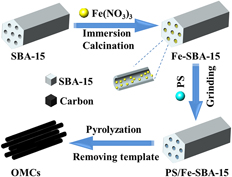Crossref Citations
This article has been cited by the following publications. This list is generated based on data provided by
Crossref.
Tripathi, Pranav K.
Durbach, Shane
and
Coville, Neil J.
2019.
CVD Synthesis of Solid, Hollow, and Nitrogen-Doped Hollow Carbon Spheres from Polypropylene Waste Materials.
Applied Sciences,
Vol. 9,
Issue. 12,
p.
2451.
Kim, Soosan
Lee, Nahyeon
and
Lee, Jechan
2020.
Pyrolysis for Nylon 6 Monomer Recovery from Teabag Waste.
Polymers,
Vol. 12,
Issue. 11,
p.
2695.
Daniel, Giorgia
Kosmala, Tomasz
Dalconi, Maria Chiara
Nodari, Luca
Badocco, Denis
Pastore, Paolo
Lorenzetti, Alessandra
Granozzi, Gaetano
and
Durante, Christian
2020.
Upcycling of polyurethane into iron-nitrogen-carbon electrocatalysts active for oxygen reduction reaction.
Electrochimica Acta,
Vol. 362,
Issue. ,
p.
137200.
Lee, Nahyeon
Kim, Soosan
and
Lee, Jechan
2021.
Valorization of waste tea bags via CO2-assisted pyrolysis.
Journal of CO2 Utilization,
Vol. 44,
Issue. ,
p.
101414.
Ren, Shiying
Xu, Xin
Hu, Kunsheng
Tian, Wenjie
Duan, Xiaoguang
Yi, Jiabao
and
Wang, Shaobin
2022.
Structure-oriented conversions of plastics to carbon nanomaterials.
Carbon Research,
Vol. 1,
Issue. 1,
Yaqoob, Lubna
Noor, Tayyaba
and
Iqbal, Naseem
2022.
Conversion of Plastic Waste to Carbon-Based Compounds and Application in Energy Storage Devices.
ACS Omega,
Vol. 7,
Issue. 16,
p.
13403.
da Silva, Elisangela Pacheco
Fragal, Vanessa Hafemann
Fragal, Elizângela Hafemann
Sequinel, Thiago
Gorup, Luiz Fernando
Silva, Rafael
and
Muniz, Edvani C.
2023.
Sustainable energy and waste management: How to transform plastic waste into carbon nanostructures for electrochemical supercapacitors.
Waste Management,
Vol. 171,
Issue. ,
p.
71.
Baskan-Bayrak, Havva
Aliyeva, Nargiz
Sorayani Bafqi, Mohammad Sajad
and
Okan, Burcu Saner
2023.
Graphene Extraction from Waste.
p.
117.
Moradi, Zahra
and
Ghorbani-Choghamarani, Arash
2023.
Green preparation and characterization of AGC-ZM-2022 as a novel mesoporous silica material using palmitic acid as a natural template.
RSC Advances,
Vol. 13,
Issue. 4,
p.
2265.
Kim, Kue-Ho
Song, Yun-Jae
and
Ahn, Hyo-Jin
2023.
Protein-assisted bendable Cu-free anode: Hydroxy-functionalized mesoporous carbon matrix for flexible Li-ion batteries.
Applied Surface Science,
Vol. 608,
Issue. ,
p.
155084.
Tang, Guoqiang
Qiao, Wenyuan
Wang, Zheng
Liu, Fang
He, Liang
Liu, Minghao
Huang, Wenbo
Wu, Hongqu
and
Liu, Changhui
2023.
Waste plastic to energy storage materials: a state-of-the-art review.
Green Chemistry,
Vol. 25,
Issue. 10,
p.
3738.
Sahu, Swati
Rathore, Gajendra Singh
and
Tiwari, Sanjay
2023.
Carbon Allotropes and Composites.
p.
229.
Pereira, Ledicia
Castillo, Ventura
Calero, Mónica
Blázquez, Gabriel
Solís, Rafael R.
and
Martín-Lara, M. Ángeles
2024.
Insights into using plastic waste to produce activated carbons for wastewater treatment applications: A review.
Journal of Water Process Engineering,
Vol. 62,
Issue. ,
p.
105386.
Mohamed, Manal G.
Mansour, Nahla A.
Fathy, Dalia S.
and
Mazrouaa, Azza M.
2024.
Waste-Derived Nanoparticles.
p.
185.
Mehta, Jyotsana
Dilbaghi, Neeraj
Deep, Akash
Hai, Faisal I.
Hassan, Ashraf Aly
Kaushik, Ajeet
and
Kumar, Sandeep
2025.
Plastic waste upcycling into carbon nanomaterials in circular economy: Synthesis, applications, and environmental aspects.
Carbon,
Vol. 234,
Issue. ,
p.
119969.
Moses, Kigozi
Karume, Ibrahim
Bbumba, Simon
Parvathalu, Kalakonda
Kasozi, Gabriel
and
Tebandeke, Emmanuel
2025.
None-emission carbon nanomaterial derived from polystyrene plastic waste for the adsorption of carbon dioxide.
Results in Materials,
Vol. 26,
Issue. ,
p.
100671.
Pirani, Mahdi
Meiabadi, Mohammad Saleh
Moradi, Mahmoud
Enriquez, Lissette Garcia
Sreenivasan, Sreeprasad T.
and
Farahani, Saeed
2025.
On the Potential of Upcycling Plastic Wastes to Carbon-Capturing
Materials Using Supercritical Fluid-Assisted Injection Molding
Process.
SAE International Journal of Sustainable Transportation, Energy, Environment, & Policy,
Vol. 5,
Issue. 3,
